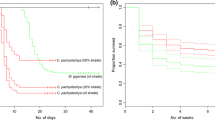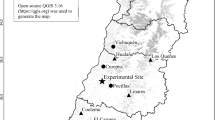Abstract
Cercidiphyllum japonicum Sieb. etZucc. is found in riparian forests in Japan, but the seedlings rarely regenerate more than coexisting tree species. We investigatedC. japonicum emergence and seedling survival in a nursery for 21 months. Bare soil, soil-with-litter, and gravel treatments and 3.0%, 10.9%, 22.7%, 60.1%, and 100% relative photosynthetic photon flux density (RPPFD) light conditions were tested. Seedling emergence depended on soil type and light conditions. Owing toC. japonicum’s small seed size, germinated seedlings could not penetrate the litter layer and became desiccated in gravel, but most seedlings emerged and survived in bare soil. These surviving seedlings needed quite bright light to germinate but not extreme light conditions. Initial mortality was high, but most of the seedlings that survived the first three months survived for the duration of the study, even under quite dark 10% RPPFD conditions. Current-year seedlings grew poorly under bright light conditions and rarely survived under the brightest light condition, when survival was probably negatively affected by desiccation. After one year, seedlings were able to use the higher light conditions more efficiently for growth. Such seedlings probably have a high chance of survival. Under low light conditions, both current- and second-year seedlings grew poorly. However, even small seedlings are likely to survive under low light conditions in a nursery, because the seedbed is level and nursery seedlings do not face all of the threats that are present in an actual forest.
Similar content being viewed by others
References
Ann W.S. &Oshima Y. (1996): Structure and regeneration ofFraxinus spaethiana-Pterocarya rhoifolia forests in unstable valleys in the Chichibu Mountains, central Japan.Ecol. Res. (Tokyo) 11: 363–370.
Bewley J.D. &Black M. (1994):Seeds: physiology of development and germination. Ed. 2. Plenum Press, New York.
Duncan R.P. (1993): Flood disturbance and the coexistence of species in a lowland podocarp forest, south Westland, New Zealand.J. Ecol. 81: 403–416.
Farmer R.E. (1997):Seed ecophysiology of temperate and boreal zone forest trees. St. Lucie Press, Delray Beach.
Fenner M. (1985):Seed ecology. Chapman & Hall, London.
Fujimoto S. &Matano R. (1994): Growth patterns ofCercidiphyllum japonicum saplings — Field surveys, growth increments and branching patterns.Bull. Shizuoka Univ. Forests 18: 89–95 (in Japanese with English summary).
Griffin J.R. (1971): Oak regeneration in the upper Carmel Valley, California.Ecology 52: 862–868.
Ito S. &Nakamura F. (1994): Forest disturbance and regeneration in relation to earth surface movement.Jap. J. Forest Environm. 36(2): 31–40 (in Japanese with English summary).
Johnson W.C., Burgess R.L. &Keammerer W.R. (1976): Forest overstory vegetation and environment on the Missouri River floodplain in North Dakota.Ecol. Monogr. 46: 59–84.
Kalliola R. &Puhakka M. (1988): River dynamics and vegetation mosaicism: a case study of the River Kamajohka, northernmost Finland.J. Biogeogr. 15: 703–719.
Kayane I. (1980):Physical geography course volume 5, Hydrology. Daimei-do, Tokyo (in Japanese).
Kisanuki H., Kaji M. &Suzuki K. (1995): The survival process of ash (Fraxinus spaethiana Ling.) and wingnut (Pterocarya rhoifolia Sieb. etZucc.) seedlings at the riparian forest at Chichibu mountains.Bull. Tokyo Univ. Forests 93: 49–57 (in Japanese with English summary).
Kovalchik B.L. &Chitwood L.A. (1990): Use of geomorphology in the classification of riparian plant associations in mountainous landscapes of central Oregon, USA.Forest Ecol. Managem. 33/34: 405–418.
Kubo M., Shimano K., Sakio H. &Ohno K. (2000): Germination sites and establishment conditions ofCercidiphyllum japonicum seedlings in the riparian forest.J. Jap. Forest. Soc. 82: 349–354 (in Japanese with English summary).
Kubo M., Shimano K., Ohno K. &Sakio H. (2001a): Relationship between habitats of dominant trees and vegetation units in Chichibu Ohyamasawa riparian forest.Veg. Sci. 18: 75–85 (in Japanese with English summary).
Kubo M., Shimano K., Sakio H. &Ohno K. (2001b): Sprout trait ofCercidiphyllum japonicum based on the relationship between topographies and sprout structure.J. Jap. Forest. Soc. 83: 271–278 (in Japanese with English summary).
Pons T.L. (1992): Seed responses to light. In:Fenner M. (ed.),Seeds: The ecology of regeneration in plant communities, Alden Multimedia Ltd, Trowbridge, pp. 259–284.
Sakio H. (1997): Effects of natural disturbance on the regeneration of riparian forests in a Chichibu Mountains, central Japan.Pl. Ecol. 132: 181–195.
Sakio H., Kubo M., Shimano K. &Ohno K. (2002): Coexistence of three canopy tree species in a riparian forest in the Chichibu Mountains, central Japan.Folia Geobot. 37: 45–61.
Sato H. (1988): The structure and habitat ofPterocarya rhoifolia forest in Matsumae Peninsula, Southern Hokkaido, Japan.Jap. J. Forest Environm. 30(1): 1–9 (in Japanese with English summary).
Seiwa K. &Kikuzawa K. (1996): Importance of seed size for the establishment of seedlings of five deciduous broad-leaved tree species.Vegetatio 123: 51–64.
Sydes C. &Grime J.P. (1981a): Effects of tree leaf litter on herbaceous vegetation in deciduous woodland. I. Field investigations.J. Ecol. 69: 237–248.
Sydes C. &Grime J.P. (1981b): Effects of tree leaf litter on herbaceous vegetation in deciduous woodland. II. An experimental investigation.J. Ecol. 69: 249–262.
Takeuchi T. (1975):Method of seedling breeding for greenery-trees: Treatment of seed and tailoring of seedling. So-bun, Tokyo (in Japanese).
White P.S. (1979): Pattern, process, and natural disturbance in vegetation.Bot. Rev. 45: 229–299.
Yamamoto S. (1987): Germination trait of seedling — Demography of seedlings.Northern Forestry, Japan 39: 97–101 (in Japanese).
Author information
Authors and Affiliations
Rights and permissions
About this article
Cite this article
Kubo, M., Sakio, H., Shimano, K. et al. Factors influencing seedling emergence and survival inCercidiphyllum japonicum . Folia Geobot 39, 225–234 (2004). https://doi.org/10.1007/BF02804779
Received:
Revised:
Accepted:
Issue Date:
DOI: https://doi.org/10.1007/BF02804779




